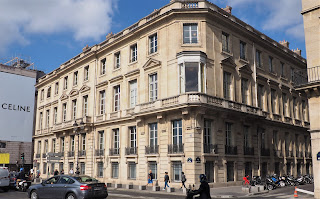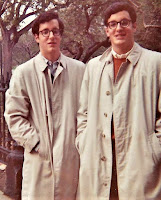Last September, we spent 5 days and 5 nights each in Paris and Berlin. It was our second trip to Paris – our first was in 1975 – and first to Berlin. Both cities have very interesting dynamics relating to life there during the 1930s and 1940s, most notably the rule by the Nazis.
Arc de Triomphe and Brandenburg Gate
After returning from our trip, a relative remarked he found Berlin a bit “creepy,” although it had been a few years since he had been there. I responded I’d tried to keep from dwelling on what was as opposed to what is now. In addition, the only Nazi government building still standing is the Reichsluftfahrtministerium (Ministry of Aviation), a Brutalist building housing the German Finance Ministry. Hitler’s bunker is below a nondescript surface parking lot, and all other Nazi buildings were either destroyed by Allied bombings or postwar demolitions. The most interesting parts of the city turned out to be in the former East Berlin rather than in West Berlin.
Reichsluftfahrtministerium (Ministry of Aviation)
Berlin has three major sites in the city featuring education about the Jews of German and the Holocaust. Best known are The Memorial to the Murdered Jews of Europe and Information Centre, also known as the Holocaust Memorial; Topography of Terror; and the Jewish Museum of Berlin. The Memorial to the Sinti and Roma Victims of National Socialism, near the Reichstag, also honors those murdered simply for being who they were. All provide extensive commentary on this terrible era. Plaques in the Jewish Quarter and the Neue Synagogue provide additional information about the era.
The
Memorial to the Murdered Jews of Europe
Topography of Terror
Jewish Museum of Berlin
The
Memorial to the Murdered Jews of Europe (Reichstag in background)
The Information Centre, located beneath the Memorial, begins with a timeline for the Final Solution from when the Nazis took power in 1933 through the murder of 500,000 Soviet Jews in 1941. The rest of the exhibition is divided into four rooms dedicated to personal aspects of the tragedy: individual families or letters thrown from the trains that transported them to the death camps. The Room of Families focuses on the fates of 15 specific Jewish families. In the Room of Names, names of all known Jewish Holocaust victims obtained from the Yad Vashem memorial are read out loud. Each chamber contains visual reminders of the stelae above: rectangular benches, horizontal floor markers and vertical illuminations.
Information Centre
The Jewish Museum Berlin is the largest Jewish museum in Europe. It consists of three buildings, two of which are new additions specifically built for the museum by architect Daniel Libeskind. The W. Michael Blumenthal Academy of the Jewish Museum Berlin was built – also after a design by Libeskind – adjacent to the building in 2011 and 2012 in the former flower market hall. The archives, library, museum education department, lecture hall and Diaspora Garden are located here. The museum essentially consists of two buildings – a baroque old building, the “Kollegienhaus” (that formerly housed the Berlin Museum), and a new, deconstructivist-style building by Libeskind. The two buildings have no visible connection above ground. The 161,000 square-foot Libeskind building contains twisted passages and is accessible only via an underground entrance from the old building. Construction on the new extension to the museum began in November 1992. The empty museum was completed in 1999 and attracted more 350,000 people before it was filled and opened in September 2001.
Jewish Museum of Berlin
The Topography of Terror is located on the site of
buildings that housed the SS Reich Main Security Office, the headquarters of the Sicherheitspolizei, SD,
Einsatzgruppen
and Gestapo.
The Gestapo and SS headquarters buildings were largely destroyed by Allied
bombing during early 1945; the ruins were demolished after the war. The
boundary between the American and Soviet zones of occupation ran along
Prinz-Albrecht-Strasse; thus the street soon became a fortified boundary. The Berlin Wall
ran along the south side of Niederkirchnerstrasse. The wall here was never
demolished. The section adjacent to the Topography of Terror is the longest
extant segment of the outer wall.
Topology of Terror
The first exhibitions on the site took place in 1987, as part of Berlin's 750th anniversary. The cellar of the Gestapo headquarters, where many political prisoners were tortured and executed, was found and excavated. The site was then turned into an open-air memorial and museum, protected from the elements by a canopy, detailing the history of Nazi repression. A joint exhibition was shown both at the site and in East Germany in 1989. In 1993, three years after German reunification, a foundation established to take care of the site chose architect Peter Zumthor to design a permanent museum. However, construction was stopped due to funding problems after the concrete core of the structure had been built, which stood on the site for nearly a decade until it was demolished in 2004 and a new building begun. Construction of the new Documentation Center by architect Ursula Wilms and landscape architect Heinz W. Hallmann was finished in 2010.
Topology of Terror
Paris, mainly thanks to German Gen. Dietrich von Cholititz, who defied Hitler’s directive to totally destroy the city in August 1944 before the Allies retook Paris (leading to the famous question, “Is Paris burning?”), still looks like one huge movie set. Beneath it lies the ugly history of Nazi occupation, aided in large part by collaborators and the Vichy State in southern France. I found thoughts about the former Nazi headquarters I photographed, as well as historic photographs of SS officers lounging on the Champs-Élysées and the Nazi flag flying atop the Eiffel Tower, to be as unnerving as any I would have in Berlin.
Paris (from Centre Pompidou observation deck)
The Peninsula Paris, opened in 1908 as the Hotel Majestic, served as the headquarters of the German military high command in France during the German occupation from October 1940 to July 1944. Formerly the site of the palace of Queen Isabella II of Spain, hotelier Leonard Tauber constructed the Hotel Majestic, retaining Queen Isabella's bathroom accoutrements, including her marble bath, in the Presidential suite. Designed by Armand Sibien, construction began in 1906 and was completed in 1908. The hotel was purchased for use as a military hospital at the outbreak of World War I and served in this capacity for five months. It was damaged during its hospital service and was not renovated and reopened until 1916. It was purchased by the French government in 1936 to serve as offices for the Ministry of Defence . After the war, The Majestic served as the first headquarters of UNESCO until 1958, when it was converted into a conference center for The Organization for Economic Co-operation and Development, founded at the hotel in 1960. It was also the location for the signing of the Paris Peace Accords on January 27, 1973, ending American involvement in the Vietnam War. The French government sold the building in 2008 to Qatari Diar for $460 million. It reopened on August 1, 2014. The hotel offers 200 luxury rooms, including 34 suites, ranging from $750 to more than $1,000 a night.
Peninsula Paris
Sofitel Le Scribe Paris
Opéra
11 Rue des Saussaies was Gestapo headquarters for occupied Paris during World War II. After the war, the building housed the Ministry of the Interior, including the Sûreté nationale.
11 Rue des Sassaies
I did not have the correct address for the Hotel Meurice on the Rue de Rivoli but found it as part of a wide-angle photograph. The hotel opened in 1815. Between September 1940 and August 1944, the hotel was requisitioned by the German occupation authorities. In August 1944, the Meurice became the headquarters of General Dietrich von Choltitz, the military governor of Paris. As noted earlier, von Choltitz famously disobeyed Hitler's commands to level the city of Paris. Hitler's reported screamed to von Choltitz over a Hotel Meurice telephone, "Is Paris burning?" Rooms now go for more than $1,000 a night.
Hotel Meurice (domed building to the left)
Hotel Saint-Florentin
This is not to say there are no acknowledgements of the Nazi occupation in Paris. Two sites in particular memorize those lost in the Holocaust.
The Memorial to the Martyrs of the Deportation honors the 200,000 people who were sent from Vichy France to Nazi concentration and death camps. Located on the site of a former morgue, it was designed by architect Georges-Henri Pingusson and inaugurated in 1962. The memorial is shaped like a ship's prow; the crypt is accessible by two staircases and a lowered square. The crypt leads to a hexagonal rotunda that includes two chapels containing earth and bones from concentration camps. The memorial's narrow entrance is marked by two concrete blocks. Along both walls of the narrow, dimly lit chamber, 200,000 glass crystals with light shining through symbolize each deportees who died in the camps; a single bright light is located at the end of the tunnel. Urns with ashes from the camps are positioned at both lateral ends. The chamber’s ends have small rooms that seem to depict prison cells. An iron gate opposite the entrance overlooks the Seine at the tip of the Île de la Cité. A circular plaque on the floor of the underground chamber reads: "They descended into the mouth of the earth and they did not return." A "flame of eternal hope" burns and The Tomb of the Unknown Deportee bears the inscription: "Dedicated to the living memory of the 200,000 French deportees sleeping in the night and the fog, exterminated in the Nazi concentration camps."
Memorial to the Martyrs of the Deportation
Because of time constraints, we were only able to pass The Memorial of the Shoah, which opened near the Jewish Quarter in 2005. The forecourt of the memorial includes a circular memorial listing the names of the death camps and the Warsaw Ghetto. There is also a wall with seven bas-reliefs by Arbit Blatas that symbolize the camps and the persecution of the Jews. Several walls that make a passageway to the building list the names of the approximately 76,000 French Jews who were deported and murdered by the Nazis. The crypt predates the Memorial of the Shoah; in 1957, the ashes of victims from the different death camps and the Warsaw Ghetto were buried in dirt from Israel. The crypt also includes a door from the Warsaw Ghetto and the "Jewish Files" created by the Vichy government to identify Jewish citizens. These files were later used by the Nazis to locate Jews for deportation. Some 3,300 persons awarded the title "Righteous Among the Nations" to non-Jewish people who helped save Jews during the war have their names listed on the wall that runs alongside of the memorial.
Museum of the Shoah
Finally, plaques in the Jewish Quarter in the Marais District commemorate those deported from Paris as part of the Final Solution. And as a reminder that anti-Semitism never disappears, the bombing and shooting attack at Chez Jo Goldenberg restaurant on August 9, 1982, was carried out by the Abu Nidal Organization, a group that splintered from Fatah. Two assailants threw a grenade into the dining room, then rushed in and fired machine guns. Six people, including two Americans, were killed and 22 were injured. The restaurant closed in 2006 and former owner Jo Goldenberg died in 2014.
Former Chez Jo Goldenberg































